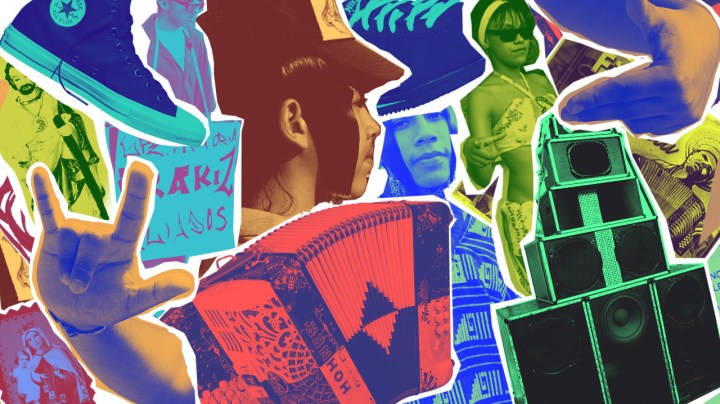1
To achieve the estilo Colombiano, you need massive amounts of gel. Use the gel to glue giant sideburns directly to your cheeks.

In 2007, English fashion designer Amanda Watkins was living in Monterrey, Mexico when she stumbled upon a group of teenagers dancing to cumbia by the river. Sporting looks best described as LA cholo meets Colombia’s Caribbean coast, their heads were crowned with elaborately gelled hairstyles, and they waved graffiti-style signs over their heads as they danced. Watkins didn’t know it then, but she’d end up devoting the next nine years of her life to documenting this working class, cumbia-centric subculture born out of Monterrey’s sonideros– a community that came to be known as “Los Cholombianos,” after Vice Mexico editor Bernardo Loyola dubbed them as such in a 2011 Vice article.
The name caught on, and it later inspired the title of Amanda Watkins’ 2015 book Cholombianos, an in-depth collection of over 150 portraits, interviews, essays, and illustrations about the Cholombian (or “Regio-Colombiano”) lifestyle. More than just an inside look at this community, the book is also an exploration of how how cultures blend in border cities, and how innovative, vibrant aesthetic movements can spring up out of poor urban environments. In this case, they are a symbol of a city that has long been the breeding ground for some of Mexico’s most important musical movements, even amidst cartel violence – and which, through artists like Celso Piña, has carved out its own cumbia identity, which fuses tropical Colombian sounds with musica norteña.
Watkins’ book has since become a multi-disciplinary traveling exhibit that brings together the sounds and colors of the Cholombiano lifestyle, including portraits, music, textiles, slang, and more. With successful shows in London and Guadalajara under her belt, Watkins, who has teamed up with Mexican publishers Trilce, is now set to take the exhibit to Mexico City, where it opens on May 19th and will run until August 28th.
In celebration of the exhibit, we’ve put together a little starter kit for those who want to know the basics of achieving the Cholombiano look. Get acquainted, gel up, and make sure to check out the Cholombianos show at Museo de la Ciudad de Mexico.
To achieve the estilo Colombiano, you need massive amounts of gel. Use the gel to glue giant sideburns directly to your cheeks.
There are sub-cliques within the Cholombiano scene – kind of like gangs, except peaceful and into stoner cumbia rebajada. Each group has their own hand signs, which you flash in a dance circle to rep your set.
A staple in the cumbia regia sound.
The Cholombiano aesthetic also usually incorporates religious iconography, both on shirts, hats, and in escapulario necklaces. There is a special affinity for la Virgin de Guadalupe and San Judas Tadeo, which is believed to be influenced by the LA cholo aesthetic.
The kicks of choice.
Although less so in the age of streaming, pirated CDs are still a way of getting and sharing new cumbia tracks.
For blasting the chunes.
These religious-style icons are worn around the neck and are used to rep the clique you belong to, the radio station you like, and any other information you want to broadcast. These personalized escapularios are made by hand and highly personal.
Cholombiano crews are known to call their favorite radio stations with long lists of 60+ person shout-outs to their friends and girlfriends.
These shirts normally feature colorful aztec prints that reference prehispanic textiles.
